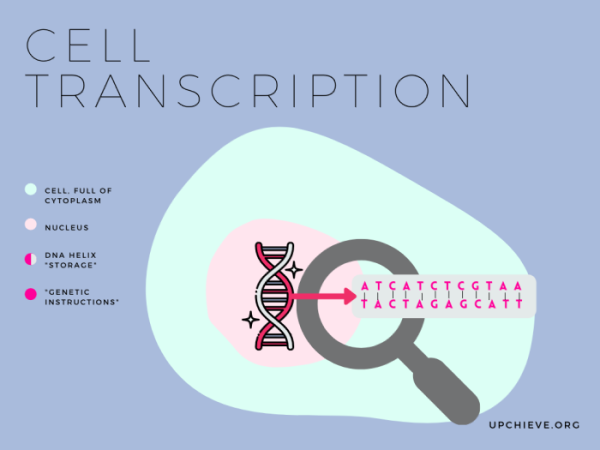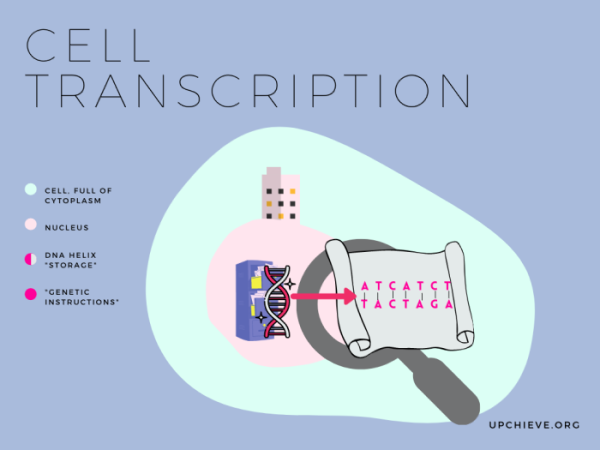What is the Difference between Transcription and Translation?
Transcription and translation can be confusing. Basically, DNA is transcribed into RNA which is then translated into proteins. Yet as with most things in biology, each process has multiple steps with different actors–all with new unusual names–and that can make it difficult to keep all the details organized.
So, if you’re still struggling to understand the difference between transcription and translation, you’ve come to the right place! Here’s a simple study guide that explains transcription through its three steps: initiation, elongation, and termination.
What is cell transcription?
Transcription takes place inside the cell. More specifically, it is inside the cell’s nucleus beyond the rest of the cytoplasm. The nucleus has “storage space” called DNA to hold instructions on how to make things such as proteins and polypeptides.
These instructions, called genes, look like codes made up of 4 nitrogenous bases: adenine (A), cytosine (C), guanine (G), and thymine (T). There is so much genetic instruction that it can only fit inside if it is packed up into 23 chromosome pairs and then wound up into a helix.
Already confused? A story analogy might help. Imagine the cell as a busy city of cytoplasm. The Mayor sits in the nucleus headquarters. He has written down instructions on how to build everything in the city. These blueprints (genes) have so much information, all in his code of ACGTs. These are rolled up and stuffed into the DNA file cabinet. The Mayor will share his blueprints to help others build streets, skyscrapers, homes, and so on.
But there is a process before that blueprint (gene) can be used to make an actual building (protein). The first step in that process is initiation.
step 1: INITIATION
RNA polymerase copies the instructions on the DNA strand.
Throughout a cell’s life, those protein-building instructions will be continuously copied. That job is given to an enzyme called RNA polymerase. RNA polymerase finds an area of the strand that is marked as the promoter region. It includes the TATA box (due to the nucleotide sequence there spelling TATA). RNA polymerase binds to the promoter region and can start transcribing. With DNA helicase, it “unzips” the helix and exposes each individual DNA strand. It choose one side as a template to copy.
In our analogy, RNA polymerase is like a scribe who must find instructions inside the DNA file cabinet at the nucleus headquarters. He doesn’t want to photocopy everything in the DNA, like DNA replication. He is only looking for information that can help build proteins. The promotor region is like a cubicle with a TATA-desk, set up for RNA polymerase to work at. Once settled in, RNA polymerase can unwind the DNA strands and copy one onto his own long nucleotide notepaper.
STep 2: ELONGATION
RNA polymerase transcribes the instructions from the single DNA strand with complementary nucleotides. This string of information will be called mRNA, or messenger RNA because it will eventually carry the DNA’s information out. For now, though, it is called pre-mRNA because the transcription is not complete.
As the polymerase moves down the strand, the pre-mRNA transcription gets longer and longer.
This mRNA isn’t completely identical to the DNA strand. The mRNA is only one strand, unlike the double-stranded DNA. Also, DNA and RNA only share 3 of the 4 nitrogenous bases: adenine (A), cytosine (C), and guanine (G). RNA replaces the thymine (T) in the DNA code with uracil (U).
When does RNA polymerase know when to stop transcribing information?
Step 3: TERMINATION
RNA polymerase must know when to stop transcribing information. Eventually, it will find a section called the terminator (either as a sequence of nucleotides that signal the end or a special protein that acts like a block). When it reaches that point, RNA polymerase pulls away from the DNA template. However, the pre-mRNA needs one more step before it can be dispatched out to the cytoplasm.
The pre-mRNA copy still needs to be edited - much like messy and disjointed notes. Other enzymes come to tidy it up by erasing blank spots (introns) and resplicing the string together. A poly-A tail code, essentially delivery instructions, is attached to one end. After this, it is the “final draft” just called mRNA. The transcription is now complete and ready to be shared.
What is cell translation?
So, mRNA heads out of the nucleus to deliver building instructions. There is a problem though. Ribosome, a protein-synthesizing structure, cannot read the code. It must undergo a process of translation before that mRNA can be used to actually build. What happens now?
It is now time to contact a virtual tutor to learn how translation completes the building process. Why? One-on-one tutoring can help you break down the difference between transcription and translation in a way that makes sense for you!
The nonprofit UPchieve offers free, on-demand, online tutoring for Title 1 High School students. For more help with Biology, check on our student page to see if your school qualifies. You can connect with an Academic Coach in as little as five minutes.





